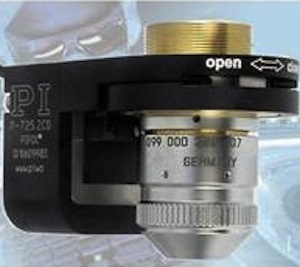Microscope applications that require the fastest possible autofocus with real-time continuous optimization are addressed by the combination of Motion X FocusTrac™ and PI objective and Z positioners.
Two tasks are critical to the use of microscopes: achieving and maintaining a sharp focus and a real-time autofocus during processes in which the substrate is moved. Several approaches exist:
- Probe-based mechanisms compensate for drift by measuring the position of the sample plate versus the optical column. Drawbacks include slow speed, cumbersome setup and limited resolution due to slop and stiction at the probe/sample interface. In addition, these mechanisms only maintain a mechanical setpoint. They cannot correct for variations in sample thickness, drift between the point of probe measurement and the sample, parfocality errors between objectives, drift in the optics or the column itself, and so on.
- Optical autofocus techniques evaluate an image through the optics. All mechanical, thermal and optical issues, which can affect focus including changes and steps in the sample itself, are compensated.
These techniques fall into two broad camps:
—->Image-based autofocus relies on software processing of a camera image to command a corrective position change.
—->Laser autofocus inserts a laser source beam into the optical path as a sensitive optical probe to measure focus. In theory, laser autofocus has the best potential for high-bandwidth performance.
The engineers at Motion X have developed and refined a novel laser-based mechanism that when combined with Physik Instrumente’s (PI) PIFOC objective and Z positioners (which are 10X faster than stepper or servo focusers) delivers autofocus on par with laser based autofocus. The laser-based mechanism is highly responsive and delivers high-throughput autofocus. Its configurable approach avoids image degradation and is suitable for commercial and custom microscopes and for substrates ranging from wafers with sensitive coatings to live biological samples.

The laser-based mechanism accomplishes these feats through Piezoelectric actuation. The popularity of piezoelectric technology as focusing mechanisms comes from their high speed compared to that of stepper and servo focusing mechanisms. They are also able to focus quickly to nanoscale precision, where stepper and servo mechanisms may not perform repeatably or stably. And piezos’ resolution is essentially unlimited, so they are at the heart of atomic force microscopy and advanced lithography, among other applications.
How it works: FocusTrac™ introduces a collimated laser source beam into the optical path of a microscope system through a custom designed dichroic narrow-band beamsplitter. The beamsplitter reflects the laser source at an incident angle of 45° and is highly transmissive to other visible and infrared wavelengths, so the laser beam does not affect the image. The beam is directed through the objective to the sample, where it bounces back and is directed to a position sensitive detector. A real-time error signal is thereby generated and presented to the PI piezo controller. It is processed as a sensor input, and the controller actuates the piezo to bring the observed out-of-focus error signal to null. A front-panel offset knob and BNC input allow focusing to a defined offset from the sensor null position if desired, allowing easy accommodation of cover slips and coatings.
Both the FocusTrac™ sensor output and the PI controller’s servo methodology are based on high-bandwidth, real-time analog circuits, so system responsiveness is virtually instantaneous and image optimization operates continuously. Tracking wedged or wavy surfaces is automatic and fast. Step-height changes in the sample are accommodated swiftly and without hunting and overshoot. Both random and cyclic flatness errors are compensated— ideal for spinning-substrate applications in semiconductor and data storage production and metrology.
Mechanical options for this approach include objective positioners, turret positioners and sample-positioning Z stages. FocusTrac™ works with microscopes from industry leaders including Olympus, Leica, Nikon, Zeiss and Mitutoyo.
Motion X
www.motionxcorp.com
PI (Physik Instrumente)
www.pi-usa.us
Filed Under: Factory automation, SENSORS, TEST & MEASUREMENT, Motion control • motor controls





Tell Us What You Think!